Saint Cecilia
Saint Cecilia (Latin: Sancta Caecilia) is a saint venerated in the Latin Catholic, Eastern Catholic and Eastern Orthodox churches, as well as some churches of the Anglican Communion. She is one of seven women, in addition to the Blessed Virgin, commemorated by name in the Canon of the Mass in the Roman Catholic Church. She is regarded as the patron saint of musicians. It is written that as the musicians played at her wedding she "sang in her heart to the Lord".[2][3] Her feast day is on November 22.[4]
Saint Cecilia | |
|---|---|
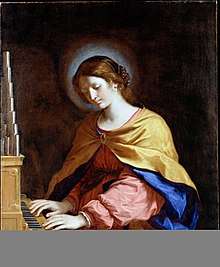 Saint Cecilia playing the pipe organ | |
| Virgin and Martyr | |
| Born | 200 AD - 230 AD Rome |
| Died | 176–180 or 222–235 AD[1] Sicily |
| Major shrine | Santa Cecilia in Trastevere, Rome |
| Feast | November 22 |
| Attributes | Flute, organ, roses, violin, harp, Baritone harpsichord, songbird, singing |
| Patronage | Hymns, great musicians, poets; Albi, France; Archdiocese of Omaha; Mar del Plata, Argentina, Pipe organs |
An early church, Santa Cecilia in Trastevere, was founded in the 3rd century by Pope Urban I in the Trastevere section of Rome, reputedly on the site of the house in which she lived. A number of musical compositions are dedicated to her, and her feast day has become the occasion for concerts and musical festivals.
Life
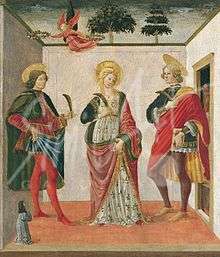
It is popularly supposed that Cecilia was a noble lady of Rome[3] who, with her husband Valerian, his brother Tiburtius, and a Roman soldier named Maximus, suffered martyrdom in about 230, under the Emperor Alexander Severus.[5][6] Giovanni Battista de Rossi, however, argues that instead she perished in Sicily under the Emperor Marcus Aurelius between 176 and 180, citing the report of Venantius Fortunatus, Bishop of Poitiers (d. 600).[7]
According to the story, despite her vow of virginity, she was forced by her parents to marry a pagan nobleman named Valerian. During the wedding, Cecilia sat apart singing to God in her heart, and for that she was later declared the saint of musicians.[3] When the time came for her marriage to be consummated, Cecilia told Valerian that watching over her was an angel of the Lord, who would punish him if he sexually violated her but would love him if he respected her virginity. When Valerian asked to see the angel, Cecilia replied that he could if he would go to the third milestone on the Via Appia and be baptized by Pope Urban I. After following Cecilia's advice, he saw the angel standing beside her, crowning her with a chaplet of roses and lilies.[3]
The martyrdom of Cecilia is said to have followed that of her husband Valerian and his brother at the hands of the prefect Turcius Almachius.[8] The legend about Cecilia's death says that after being struck three times on the neck with a sword, she lived for three days, and asked the pope to convert her home into a church.[9]
Cecilia was buried in the Catacomb of Callixtus, and later transferred to the Church of Santa Cecilia in Trastevere. In 1599, her body was found still incorrupt, seeming to be asleep.[3]
Cecilia is one of the most famous of the Roman martyrs, although some elements of the stories recounted about her do not appear in the source material.[9] According to Johann Peter Kirsch, the existence of the martyr is a historical fact, while some details bear the mark of a pious romance, like many other similar accounts compiled in the fifth and sixth century. The relation between Cecilia and Valerian, Tiburtius, and Maximus, mentioned in the Acts of the Martyrs, has some historical foundation. Her feast day has been celebrated since about the fourth century.[10] There is no mention of Cecilia in the Depositio Martyrum, but there is a record of an early Roman church founded by a lady of this name, Santa Cecilia in Trastevere.[11]
Santa Cecilia in Trastevere
The church of Santa Cecilia in Trastevere is reputedly built on the site of the house in which she lived. The original church was constructed in the fourth century; during the ninth century, Pope Paschal I had remains which were supposedly hers buried there. In 1599, while leading a renovation of the church, Cardinal Paolo Emilio Sfondrati had the remains, which he reported to be incorrupt, excavated and reburied.[12]
Meaning of the name 'Cecilia'
The name "Cecilia" applied generally to Roman women who belonged to the plebeian clan of the Caecilii. Legends and hagiographies, mistaking it for a personal name, suggest fanciful etymologies. Among those cited by Chaucer in "The Second Nun's Tale" are: lily of heaven, the way for the blind, contemplation of heaven and the active life, as if lacking in blindness, and a heaven for people to gaze upon.[13]
Patroness of musicians

The first record of a music festival in her honor was held at Évreux in Normandy in 1570.[14]
The Accademia Nazionale di Santa Cecilia in Rome is one of the oldest musical institutions in the world. It was founded by the papal bull, Ratione congruit, issued by Sixtus V in 1585, which invoked two saints prominent in Western musical history: Gregory the Great, after whom Gregorian chant is named, and Saint Cecilia, the patron saint of music.
Her feast day became an occasion for musical concerts and festivals that occasioned well-known poems by John Dryden and Alexander Pope[15] and music by Henry Purcell (Ode to St. Cecilia); several oratorios by Marc-Antoine Charpentier (In honorem Caeciliae, Valeriani et Tiburtij canticum; and several versions of Caecilia virgo et martyr to libretti probably written by Philippe Goibaut); George Frideric Handel (Ode for St. Cecilia's Day; Alexander's Feast); Charles Gounod (St. Cecilia Mass); as well as Benjamin Britten, who was born on her feast day (Hymn to St Cecilia, based on a poem by W. H. Auden). Herbert Howells' A Hymn to Saint Cecilia has words by Ursula Vaughan Williams; Gerald Finzi's "For Saint Cecilia", Op. 30, was set to verses written by Edmund Blunden; Michael Hurd's 1966 composition "A Hymn to Saint Cecilia"[16] sets John Dryden's poem; and Frederik Magle's Cantata to Saint Cecilia is based on the history of Cecilia.[17] The Heavenly Life, a poem from Des Knaben Wunderhorn (which Gustav Mahler used in his Symphony No. 4) mentions that "Cecilia and all her relations make excellent court musicians."
From the name of Cecilia comes Cecyliada, the name of festival of sacred, choral and contemporary music, held from 1994 in Police, Poland.
Legacy
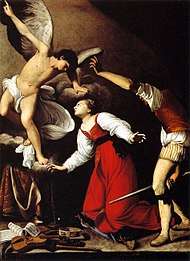
Cecilia symbolizes the central role of music in the liturgy.[9]
The Sisters of Saint Cecilia, religious sisters, shear the lambs' wool used to make the palliums of new metropolitan archbishops. The lambs are raised by the Cistercian Trappist Fathers of the Tre Fontane (Three Fountains) Abbey in Rome. The lambs are blessed by the Pope every January 21, the Feast of the martyr Saint Agnes. The pallia are given by the Pope to the new metropolitan archbishops on the Solemnity of Saints Peter and Paul, June 29.
Located on the Isle of Wight, St. Cecilia's Abbey, Ryde was founded in 1882. The nuns live a traditional monastic life of prayer and work, and study in accordance with the ancient Rule of St. Benedict.[18]
The famous luthier Jean-Baptiste Vuillaume produces a line of violin and viola under the name St. Cécile with a decal stamped on the upper back.[19]
Iconography
Cecilia is frequently depicted playing a viola, a small organ, or other musical instrument,[9] evidently to express what was often attributed to her, namely that while the musicians played at her nuptials, she sang in her heart to God, though the organ may be attributed to her erroneously,[10] as the result of a mistranslation.[20]
A miniature Saint Cecilia beneath Worcester Cathedral was featured on the reverse side of the Sir Edward Elgar £20 banknote, which was withdrawn by the Bank of England in 2010.
In music
Renaissance, baroque and classical music
- Marc- Antoine Charpentier, composed four Histoires sacrées using a text thought to have been written by his colleague Philippe Goibaut des Bois La Grugère :
- In honorem Caeciliae, Valeriani et Tiburtij canticum H 394 for 3 voices, 2 treble instruments and continuo (1675 ?).
- Caecilia virgo et martyr octo vocibus H 397 for soloists, double chorus, double orchestra and continuo (1677-78).
- Caecilia virgo et martyr, H 413 for soloists, chorus and 2 treble instruments (1683-85).
- Caecilia virgo et martyr H 415 - H 415 a for soloists, chorus and 2 treble instruments (1686).
- Henry Purcell, Ode for saint Cécila's Day Hail! Bright Cecilia (1692) and Welcome to all the pleasures.
- Sébastien de Brossard, Canticle for Saint Cécila SdB.9 (1720 ?)
- Alessandro Scarlatti Il martirio di santa Cecilia, oratorio donné pour la première fois le 1er mars 1708 ; Messa di Santa Cecilia(1720).
- Georg Friedrich Haendel composed 2 works for Saint Cecilia with John Dryden : The Oratorio Alexander's Feast or The Power of Music (1736) and Ode for St. Cecilia's Day (1739).
- Joseph Haydn, Missa Sanctae Caeciliae ou Missa Cellensis in honorem Beatissimae Virginis Mariae (1766-67).
Contemporary music
- Judith Shatin wrote The Passion of Saint Cecilia for piano and orchestra[21] and Fantasy on Saint Cecilia[22] for solo piano.[23]
- Fred Momotenko composed "Cecilia", a composition for full mixed choir, "a hymn to the past as well as to the future of the monastic tradition". The world premiere was at Koningshoeven Abbey on Saint Cecilia's feast day 2014.[24]
- Benjamin Britten wrote a Hymn to St Cecilia, a setting for the poem by W. H. Auden.
- Lou Harrison wrote his Mass for St. Cecilia's Day for choir, harp, and drone (1983-6).
- Arvo Pärt was commissioned to compose a work for the Great Jubilee in Rome in 2000, and wrote Cecilia, vergine romana (Cecilia, Roman virgin) for mixed choir and orchestra. The Italian text deals with the saint's life and martyrdom. It was first performed on 19 November 2000, close to her feast day, by the Accademia Nazionale di Santa Cecilia conducted by Myung-whun Chung.[25]
- Gerald Finzi composed "For St. Cecilia" for solo tenor, chorus (SATB) and orchestra. Setting of a work by English poet and author Edmund Blunden. Duration ca 18 minutes.
- On the 2015 Feast of Saint Cecilia, Foo Fighters released their EP "Saint Cecilia" for free download via their website. The five song EP features a track named after the EP "Saint Cecilia". The EP was recorded during an impromptu studio session at Hotel Saint Cecilia located in Austin Texas.[26]
- Informator Choristarum (organist and master of the choristers) at Magdalen College, Oxford (1957–1981), Bernard Rose's unaccompanied anthem for SATB choir (with divisions) Feast Song For St. Cecilia (1974) is a setting a poem of the same name by his son, musician Gregory Rose.
- Singer/Songwriter/Guitarist, Rik Emmett, composed the song "Calling St. Cecilia" on his 1992 LP Ipso Facto.
- Paul Simon wrote the song "Cecilia" about writer's block.
- The Chicago band Turnt (now known as Everybody All The Time) released a song called Girls which refers to St Cecilia in the lyrics. The song was first performed at Northwestern University's Mayfest Battle of the Bands on Friday May 24th 2013 at 27 Live in downtown Evanston. [27]
- On 2008 Brian Eno's and David Byrne's album "Everything That Happens Will Happen Today", Cecilia is referred to in the song "The River".[28]
In literature
- The poem "Moschus Moschiferus", by Australian poet A. D. Hope (1907–2000), is sub-titled "A Song for St Cecilia's Day". The poem is of 12 stanzas and was written in the 1960s.
- Cecilia is also the subject of Alexander Pope's poem "Ode on St. Cecilia's Day."
- Geoffrey Chaucer retells the story of Cecilia and Valerian and his brother in "The Second Nun's Tale" in The Canterbury Tales.
- Cecilia is a symbol for the divine power of music in Heinrich von Kleist's extended anecdote, "St. Cecilia, or the Power of Music".
Gallery
 Saint Cecilia and Saint Valerian, Lelio Orsi (c. 1555)
Saint Cecilia and Saint Valerian, Lelio Orsi (c. 1555)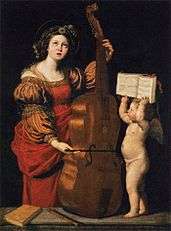 Domenichino, Saint Cecilia with an angel holding a musical score, (c. 1617–18).
Domenichino, Saint Cecilia with an angel holding a musical score, (c. 1617–18). Saint Cecilia by Raymond Monvoisin
Saint Cecilia by Raymond Monvoisin An Angel Crowning Saints Cecilia and Valerian (1330s)
An Angel Crowning Saints Cecilia and Valerian (1330s) Statue from the porch of St. Cecilia, Trastevere
Statue from the porch of St. Cecilia, Trastevere Stefano Maderno, St. Cecilia, 1599
Stefano Maderno, St. Cecilia, 1599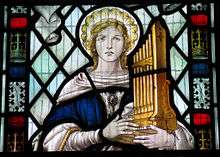 Saint Cecilia Wymondley
Saint Cecilia Wymondley Saint Cecilia stained glass by Edward Burne-Jones in All Saints church, Preston Bagot
Saint Cecilia stained glass by Edward Burne-Jones in All Saints church, Preston Bagot Franciscan Sisters' Saint Cecilia window inspires vocations at Saint Mary's Chapel, Holy Family Convent Motherhouse in Manitowoc, WI
Franciscan Sisters' Saint Cecilia window inspires vocations at Saint Mary's Chapel, Holy Family Convent Motherhouse in Manitowoc, WI
Domenichino's Fresco Cycle in San Luigi dei Francesi, Rome (1614)
 The Crowns
The Crowns Cecilia's Trial
Cecilia's Trial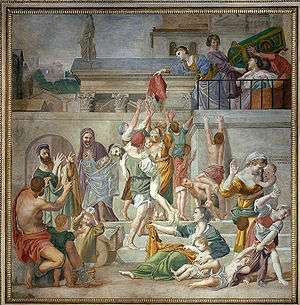 She distributes her goods to the poor
She distributes her goods to the poor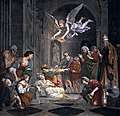 Her death
Her death
The apse mosaic in the Church of St. Cecilia in Trastevere
 The apse
The apse Detail: left side
Detail: left side Detail: right side
Detail: right side
See also
- Albi Cathedral, Albi, France
- List of Christian women of the patristic age
- St. Cecilia Cathedral, Omaha, Nebraska, United States
- St. Cäcilien, Cologne, Germany
- St. Cecilia Catholic School, Houston, Texas, United States
- Saint Cecilia, patron saint archive
- Santa Cecilia Chapel, Għajnsielem, Gozo, Malta
- Santa Cecilia Tower, Għajnsielem, Gozo, Malta
- The Ecstasy of Saint Cecilia by Raphael, Pinacoteca Nazionale di Bologna, Bologna, Italy
- Basilique-Cathédrale Sainte-Cécile, Salaberry-de-valleyfield, Quebec, Canada
References
- Dom Gaspar LeFebvre, O.S.B. (1952). The Saint Andrew Missal, with Vespers for Sundays and Feasts. Saint Paul, MN: E. M. Lohmann Co. p. 1685.
- Lovewell, Bertha Ellen. The Life of St. Cecilia, Yale Studies in English, Lamson, Wolffe, and Company, Boston, 1898
- Fr. Paolo O. Pirlo, SHMI (1997). "St. Cecilia". My First Book of Saints. Sons of Holy Mary Immaculate - Quality Catholic Publications. pp. 280–282. ISBN 978-971-91595-4-4.
- Chisholm, Hugh, ed. (1911). . Encyclopædia Britannica (11th ed.). Cambridge University Press.
- Fuller, Osgood Eaton: Brave Men and Women. BiblioBazaar, LLC, 2008, p. 272. ISBN 0-554-34122-0.
- Mason, Daniel Gregory (1917). A dictionary-index of musicians (eds. F. H. Martens, M. W. Cochran, and W. D. Darby). New York: National Society of Music. p. 74.
- Rom. sott. ii. 147.
- The Life of Saint Cecilia Archived 2007-10-11 at the Wayback Machine – Golden Legend article
- Foley O.F.M., Leonard. "Saint of the Day", (revised by Pat McCloskey), Franciscan Media ISBN 978-0-86716-887-7
- Kirsch, Johann Peter. "St. Cecilia", The Catholic Encyclopedia. Vol. 3. New York: Robert Appleton Company, 1908. 24 April 2013.
- "Feast: November 22".
- Goodson, Caroline J. (February 2007). "Material memory: rebuilding the basilica of S. Cecilia in Trastevere". Early Medieval Europe. 15: 2–34. doi:10.1111/j.1468-0254.2007.00197.x.
- Chaucer, Canterbury Tales, The Second Nun's Tale, prologue, 85–119. As the rubric to these lines declare, the nun draws her etymologies from the Legenda Aurea of Jacobus de Voragine (Jacobus Januensis - James of Genoa - in the rubric).
- "Academyofsaintcecilia.com".
- Ode on St. Cecilia's Day (composed 1711) at, for example, www.PoemHunter.com
- Published by Novello & Co., HL.14013968
- "En bemærkelsesværdig cd" (in Danish). Udfordringen. 29 January 2004. Retrieved 17 May 2012.
- "St. Cecilia's Abbey".
- "J.B. Vuillaume: soloist violin St. Cecile des Thernes".
- Verspaandonk, J. A. J. M. (1975). Het hemels prentenboek: Devotie- en bidprentjes vanaf de 17e eeuw tot het begin van de 20e eeuw. Hilversum: Gooi en Sticht. p. 15.
- "Judith Shatin - The Passion of St. Cecilia".
- noochinator (17 April 2015). "Judith Shatin: Fantasy on Saint Cecilia (1st mvt.) (Gayle Martin, piano)" – via YouTube.
- "Judith Shatin - Fantasy on St. Cecilia".
- "Alfred Momotenko - Cecilia".
- "Arvo Pärt: Cecilia, vergine romana". L'Osservatore Romano (in Italian). Retrieved 18 November 2018.
- "Foo Fighters release surprise new EP, Saint Cecilia, for free download". 23 November 2015.
- "Girls". Retrieved 20 January 2019.
- Hern, Raoul; ez; Fri.; Nov. 20; 2009. "All Times Through Paradise". www.austinchronicle.com. Retrieved 2019-08-19.CS1 maint: numeric names: authors list (link)
Further reading
- Connolly, Thomas (1995). Mourning into Joy: Music, Raphael, and Saint Cecilia. Yale. ISBN 9780300059014.
- Hanning, Barbara Russano (2004). "From Saint to Muse: Representations of Saint Cecilia in Florence". Music in Art: International Journal for Music Iconography. 29 (1–2): 91–103. ISSN 1522-7464.
- Meine, Sabine (2004). "Cecilia without a Halo: The Changing Musical Virtues". Music in Art: International Journal for Music Iconography. 29 (1–2): 104–112. ISSN 1522-7464.
- Luckett, Richard (1972–73). "St. Cecilia and Music". Proceedings of the Royal Musical Association. 99: 15–30.CS1 maint: date format (link)
- White, Bryan (2019). Music for St Cecilia's Day from Purcell to Handel. Boydell. ISBN 9781783273478.
External links
| Wikimedia Commons has media related to Saint Cecilia. |
_-_Heilige_Cecilia_in_extase_met_Paulus%2C_Johannes_(evangelist)%2C_Augustinus_en_Maria_Magdalena_-_26-04-2012_9-13-18.jpg)